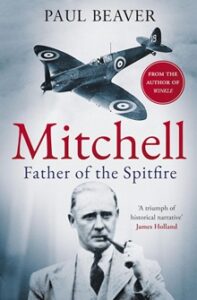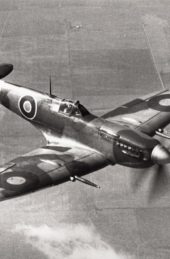To the uninitiated, the name Reginald Mitchell might well sound like a retired accountant from Surbiton. To aviation enthusiasts, however, his name is synonymous with the Spitfire. Yet, while the great “R. J. Mitchell” garnered worldwide attention with the 1942 biopic, The First of the Few, Paul Beaver, author of a compelling new book on the legendary aircraft designer, dismisses the depiction as “pure fabrication.” Instead, he views Mitchell as “the great conductor.” Thanks to his excellent Mitchell: Father of the Spitfire, it’s clear to see why.
In The First of the Few, Mitchell is portrayed as a tragic hero, solely responsible for the design of an ingenious creation that saved his country from invasion. But, as Paul Beaver argues in this well-paced, highly readable book, Mitchell was supported by a cast of young men and women the author calls “the Supermarine orchestra.” That’s not to say Mitchell is maligned in any way. Far from it.
Paul Beaver’s 40-year quest to chronicle his story (and those of the “Supermariners”) has delivered a more accurate portrayal of Mitchell. From his achievements in designing (and redesigning) flying boats, through his tenacious desire to deliver ever more speedier seaplanes, right up to his doodles (and eventual production) of arguably the finest fighter ever built (albeit by others’ hands), Mitchell: Father of the Spitfire is a veritable ode.
Passionately told across 17 chronological chapters, it charts Mitchell’s rise from Potteries railway engineer to technical director of Supermarine Aviation Works (Vickers) Ltd. His flare for innovative design (he “drew with a pencil and designed with the rubber” is a particularly striking epigram) is woven into the broader context of British interwar history.
With few landing grounds in 1919, flying boats (“not aeroplanes which float but boats which fly”) were seen as the best way to police the Empire. As the youngest chief designer in British industry at the time, the creative Mitchell set about assembling his “orchestra” to help develop what was said to be “one of the first methods of aerial locomotion.” It is this aspect of Mitchell’s work that Paul Beaver focusses on – and with good reason.
“What set Mitchell apart from most other designers,” the author suggests, “was his ability to create a team for a project.” This is clear in Mitchell’s leadership of others to help produce the winning Supermarine S5, S6, and S6b seaplanes, thus securing the Schneider Trophy for Great Britain in perpetuity. On being awarded the Commander of the Order of the British Empire (CBE) in 1932 for his achievements, he merely declared it was “one for the team.”
It is this collaboration that ultimately delivered the Supermarine Spitfire. Having been diagnosed with cancer a year after being awarded his CBE and, knowing his condition was terminal, Mitchell accelerated his projects. By 1934, he and his team had delivered the first sketches of the Supermarine Type 300. Their combined efforts eventually saw hundreds of newly-named Supermarine Spitfires ordered in June 1936 (Mitchell’s proposed name, Shrew, was thankfully overruled). Almost exactly one year later, however, Mitchell passed away, without ever knowing the lasting impact the aircraft would have. Nevertheless, as Paul Beaver points out, “he had trained a team to take the fighter through more than seventy variations before production stopped in 1948.” Mitchell’s legacy, then, is not just an iconic aeroplane, but the remarkable team he left to carry on in his wake.
Concluding with three informative appendices detailing Mitchell’s designs, the associated Air Ministry Specifications, and a contextual timeline towards the Spitfire, Mitchell: Father of the Spitfire is a superbly crafted biography that will delight aviation enthusiasts and the uninitiated alike. At last, there is now no excuse not to know the great man’s name.
Paul Bingley is an aviation historian and the author of Bomb Group.







